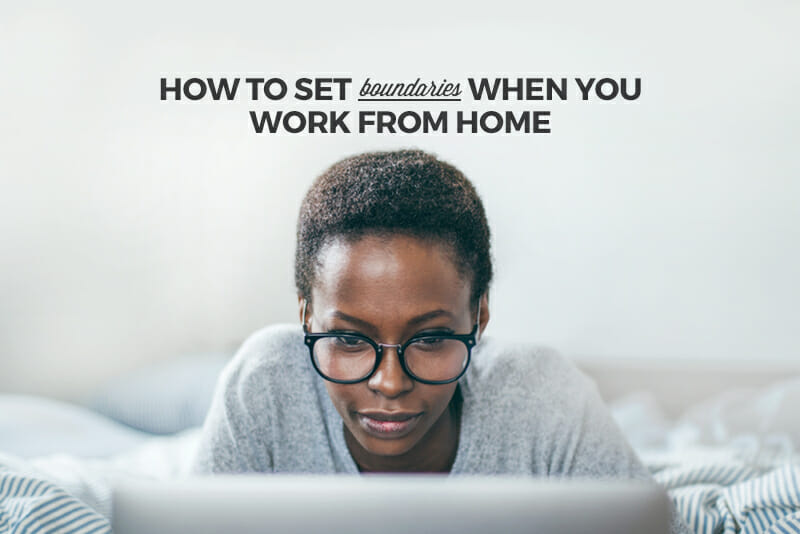How to Set Work-Life Boundaries When You Work From Home
Working from home is preferable for many people, but it still comes with some challenges. In this post, we cover some tips for healthier work-life boundaries for working from home, with advice from Skillcrush’s all-remote team.

Our entire staff here at Skillcrush is remote, and our employees live all over the world and are scattered across time zones. Flexibility is a big part of our culture here, and it was even before the global pandemic.
Working from home has plenty of perks for remote workers: flexibility, an office designed specifically for you, more hours in your day (since you can skip the commute), and the ability to cook yourself a fancy lunch that would never survive the office microwave.
For some members of our team, working from home is the key piece that allows them to have balance in their lives, especially when it comes to things like spending time with partners, friends, or kids.
Working from home is also safer, especially during a global pandemic. A study published in JAMA Internal Medicine in 2021 found that “among all adults, 49.7% of essential workers were at increased risk of severe COVID-19 using the main CDC guidelines (61.0% using the broader CDC guidelines).”
That being said, according to the Economic Policy Institute, only one in six Hispanic workers (15.2%) and one in five Black workers (20.4%) are able to telework due to COVID, compared with one in four white workers (25.9%) and two in five AAPI workers (39.2%). At Skillcrush, we’re aware of this inequality — it’s one of the reasons that our company mission is to help women, and BIPOC in particular, get higher paying and more flexible jobs in tech. (If you’re interested in starting a new tech career, we recommend checking out our Break Into Tech program. It comes with a job guarantee!)
While working from home may seem a great solution in terms of work safety during a pandemic (and heaven for extreme introverts, pandemic or not), it’s not all roses either. Without some serious work-life boundaries, working from home means that work can easily seep into the rest of your life, result in burnout, and affect your mental health.
According to a 2021 TINYpulse survey, remote employees experience the highest level of burnout (85.65%, 24% more than in person) when compared with in-person or hybrid employees. In addition, a 2021 FlexJobs survey on remote work found that overworking and struggling to unplug are the biggest challenge for remote workers.
In order to stay sharp and happy working from home, it may help to institute some home office rules and routines to make sure you develop healthier and better boundaries.
Because Skillcrush has always been remote, our staff has had years to figure out how to set healthy boundaries (with varying degrees of success). To better help you stay productive while maintaining a healthy work-life balance, I talked to my fellow Skillcrushers to see how they make working from home work for them, and their best advice for how you might be able to set healthy work-life boundaries too.

Create a Dedicated Workspace
Conventional wisdom says to have a workspace completely separate from your home life, but the entire point of working from home is to have a flexible working environment. If you’re a person who wants to work on the couch or in bed — go wild.
Confession: I’m one of those people who work from bed — mainly because my mosquito net rests on a frame around my bed and protects me from those pesky aerial vampires.
That being said, no matter where you work, you should make sure to have a dedicated working space, because if you don’t have clear boundaries, your entire house will end up becoming the workspace, even after hours.
Skillcrush’s QA Tester, Kayla, says, “I keep a dedicated workspace that I use only for work — once I close the door for the day, I try not to open it again.”
It’s worth noting, however, that not everyone has enough space in their homes to have a dedicated room for a workspace. For example, if you live in a tiny apartment or there’s not quite enough space in the home for there to be a home office, you can still create your own dedicated workspace — it doesn’t have to be a room all by itself.
Ann, Skillcrush’s Lead Development Instructor, created her workspace by carving out a corner in her living area and putting curtains around it to draw a line between her personal life and her professional life.
The separation helps her stay focused at work. According to Ann, “Before, I used to float around, but that was totally disastrous. I declutter the space before I get started and after my day. It helps me close that loop and make it so that it’s clear what that space is for. It’s not in an office, with a door, but I physically added curtains to the space, which visually stops me from seeing other people and other people from seeing me.”
Emily, our Head of Product uses the same desk for sewing and for work. She says, “I try to keep my desk minimal in that I only have the bare essentials on it, so it’s easy to clear off for sewing—and when I’m not sewing, sewing stuff is put away so it’s only my work space. I think it’s about creating the environment for what I want or need to be doing with the space and getting the other things away, because it’s just clutter at that point.”
Also note that remote work doesn’t necessarily mean working in your house.
You might find that working from home gets lonely after a while, so consider a long-term solution for working outside the house.
It could mean trying out the local coffee shops until you find one with easily accessible outlets and comfy chairs, or checking out a coworking space near you. It’s up to you to find your balance — maybe you only work out of the house one day a week. You do you.
Set Your Hours
If you’re looking specifically for a remote job because you value flexibility, you should ask questions about how scheduling at the company works and how flexible your hours will actually be during the interview process. This is especially important if you’re a parent, caretaker, have medical issues, or are juggling more than one job.
Flexibility is a key benefit of working from home, and one perk of remote work is that your hours don’t need to be the 9-5 you’d see at a traditional workplace.
But even if you prefer to work from 11:00 to 1:00, take a break, and start back up around 5:00 for another few hours, it’s a good idea to put that on your calendar and stick to it. Otherwise, it’s simply too easy for all of your hours to become half-work, half-not work, and zero percent effective or enjoyable.
I myself swear by this: I work from 3:00 PM to 7:00 PM then from 11:00 PM to 3:00 AM to have four hours of overlap with my teammates on the East and West Coasts (I myself live in East Asia). Before you look at me in horror, I prefer working late in the evening to working early in the morning, so it’s a choice I’ve fully embraced.
A HubSpot study found that without social cues to leave the office at the end of the day, many remote employees report working longer hours and having less time for social interaction outside of their home — because they get too focused on work, resulting in harm to mental health, happiness at work, and work-life balance.
For Kelli, Skillcrush’s Senior Operations Manager, it’s important to be clear about her working hours. She says, “One thing I do well is that I’m very transparent about my schedule and I make sure people know about it. That eliminates the feeling of guilt for being out at 2 PM. The more transparent I am, the better I feel and the less I feel like I’m slacking.”
If you’re a freelancer, this is super easy: designate working and personal hours (and a decent night’s — or day’s — sleep) on whatever calendar you use. If you don’t tend to work during normal business hours, block out a few weekly hours of work time during daylight that you can reserve for client meetings.
If you’re part of a remote team, suggest your coworkers take their cue from the Skillcrush crew. 😛 We keep a spreadsheet of everyone’s hours, so we can schedule meetings when we’re all awake (this is especially helpful since we’re all over the world) and so we know not to bother someone when they’re off the clock or if it’s the very end of the day for them.
In fact, this is so important that user time zones are built in as a Google Calendar feature!
And if you use a chat app like Slack, it can be helpful to turn off or mute notifications, set yourself as away or unavailable when you’re off the clock (or better yet, sign out entirely), or play with the settings until you get a mode that works best for you.
Take a Lunch Break
Another scheduling note: don’t forget lunch break. Without a group of coworkers heading out to eat or even a line at the breakroom microwave, it can be easy to forget to stop for a meal after working long hours. If you can, block out your lunch break (or some type of meal break), and schedule your work around it. Sure, things should feel flexible at home, but feeding yourself is non-negotiable — self care is important!
Randle, our Head of Content and Marketing, admits that she could be better at taking lunch breaks. “On busy days, I find I’m often eating lunch at 2 PM in full hanger mode,” she says. “Sometimes I keep delaying it and delaying it until the day is almost over anyway, and then it feels weird to leave. That’s not great for me of course, but it can also impact my team. We deserve and need to take time for ourselves, and I should reinforce that!” She’s working on it.😉
Take Your Days Off Seriously
When your home doubles as your office, it’s easy to sit down on a weekend to “just answer emails” and suddenly your “day off” has disappeared.
Yes, sometimes working on the weekends or other days off is necessary, but taking time off to recharge can do more for your mental health and well-being — not to mention productivity and energy levels —than you might realize.
For Kayla, work-life balance is super important because, “based on my experience, having a good work-life balance results in better quality output.”
It can help to try to find at least one day a week where you unplug from work completely (and maybe even spend some time with family members, roommates, or friends) since having personal time and maintaining personal relationships can help you recharge emotionally.
Kelli says, “You have to have that down time from work. It doesn’t mean you don’t love your job and aren’t dedicated to it, but you need time to recharge. It’s important to find an in-between.”

Put Some Clothes On
In that vein of separating your home and work life — it might help to put some work clothes on! That doesn’t necessarily mean a power suit or a face of makeup.
But research shows that your clothing choices while working from home can affect your productivity and performance, a concept called “enclothed cognition.”
Your work uniform can be yoga pants, a slouchy tee, or a onesie — as long as it’s not what you wake up in. In fact, more power to you if your wardrobe is filled with the world’s comfiest work sweats. Just make sure you own at least one decent looking shirt to wear for Zoom, if Zoom calls are part of your workweek.
Find Your Work Rituals
At a typical office, you’d have your mug. Maybe one of your weird coworkers would try to steal it because it had the biggest handle and you’d have to awkwardly confront him about it.
While you probably don’t have to fight any coworkers for a mug when you work from home, a surprising tip is to have a designated work mug.
The designated work mug isn’t about the vessel itself, or even the liquid inside. It’s about a ritual or morning routine that is work-specific, not house-specific. Maybe your mug is your pen or a hat you put on. The mug signals that it’s time to get into work mode, not time to check social media and have weekend morning coffee.
It’s another way to set boundaries — if you go to grab just any mug from the kitchen, you might end up doing the dishes. Then vacuuming. Then you notice the fridge could use a cleaning. There goes the morning. Your to-do list may be done, but your work hasn’t been.
Ann admits that she still has trouble with blurring boundaries, saying, “I’ll do stuff ‘on my way’ to something else, which isn’t very efficient. I’m my own worst enemy. I have to stick to the schedule that I’ve laid out and not just do a little bit more X, which accumulates over the course of the day. This becomes an extra hour of work or my brain is still at work when I’m off work. One thing I’m doing to figure this out is telling my family ‘I can do two loads of laundry and the dishes, and everything else you’re responsible for,’ etc.”
Practice Saying No
Despite the fact that the pandemic sent millions of workers home, many still seem to mistake working from home for “funemployment.” Anyone who works from home is used to the endless requests for favors during the work day.
Yes, your work-from-home job might be flexible, but you might also be expected to observe the exact same hours as the rest of your team.
Practice the following and don’t worry that someone won’t like you if you say: “No, I can’t pick you up from the airport or watch your kid or attend your community theater matinee. I’m happy to do so once I’m off work!”
Find Your WFH Community
Working from home doesn’t mean you have to constantly work in solitude. Some remote workers enjoy setting up coworking days with friends who also work from home once or twice a month.
You can even make an event out of it, like spending the first half of the day on usual work and the second half of the day taking an online course together (like Skillcrush’s Break Into Tech Course 😉), workshopping your portfolios, or generally investing in your careers.





